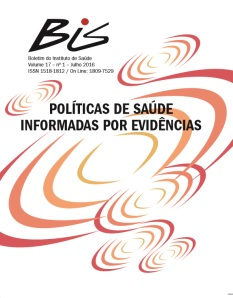Abstract
This article presents some of the main results of an Evidence Brief for Health Policy, developed in the Professional Master’s Program in Public Health of the Instituto de Saúde , in which four viable options were identified to address the problem about perinatal mortality at Porto Feliz city: a) qualification of pre -natal through risk rating for pregnant and adequacy of management of examinations; b) development of prevention and treatment protocol respiratory distress of newborn; c ) implementation of family planning with a focus on prevention of teenage pregnancy and prevention and treatment of illicit drug use during pregnancy d) structure and organization of education actions in health and home visits in prenatal and puerperium. Each identified option also took up issues related to equity and possible barriers to implementation of interventions. The analysis of equity related to the implementation of the options, especially considering access to health services, the identification of the training needs of teams to work on specific themes and the development of health education to the community were included so that options do not produce different results for different groups in the city
References
methodological quality of systematic reviews. BMC Medical Research Methodology.2007;7:10 doi:10.1186/1471-2288-7-10
2. Ministério da Saúde. Datasus. Informações de Saúde TABNET. Brasília (DF) [acesso em 8 jan 2015] Disponível em
http://www2.datasus.gov.br/DATASUS/index.php?area=0205..
3. Davey MA, Watson L, Rayner JA, Rowlands S. Risk scoring systems for predicting preterm birth with the aim of reducing associated adverse
outcomes. Cochrane DatabaseofSystematicReviews 2011, Issue 11. Art. No.:CD004902. DOI:10.1002/14651858.CD00 [acesso em
24 jun 2015.Disponível em: http://www.ncbi.nlm.nih.gov/pubmed/26490698
4. Dodd J M, Jones L, Flenady V, Cincotta R, Crowther C A. Prenatal administration of progesterone for preventing preterm birth in women considered
to be at risk of preterm birth. Cochrane Database of Systematic Reviews, Issue 8, Art. No. CD004947. DOI: 10.1002/14651858.CD004947.
pub1[acesso em 24 jun 2015] Disponível em: http://www.ncbi.nlm.nih.gov/pubmed/23903965.
5. EVIPNet: Rede para Políticas Informadas por Evidências. [Ferramenta SUPPORT] Brasília (DC). [acesso em 15 ago 2014]. Disponível em:
http://brasil.evipnet.org/..
6. UNICEF – Fundo das Nações Unidas para a Infência. Situação Mundial da Infância. Nova Iorque, 2008a [acesso em out 2014]. Disponível em:
http://www.unicef.org/brazil/pt/sowc2008_br.pdf.
7. Gogia S, Sachdev HS. Home visits by community health workers to prevent neonatal deaths in developing countries: a systematic review. Bull World
Health Organ.2010;88(9):658-666B
8. Halliday HL, Ehrenkranz RA, Doyle LW. Moderately early (7-14 days) postnatal corticosteroids for preventing chronic lung disease in preterm infants.
Cochrane DatabaseofSystematicReviews. Issue 7, Art. No. CD001144. DOI: 10.1002/14651858.CD001144.pub3 [acesso em 24 jun 2015. Disponível
em;http://www.ncbi.nlm.nih.gov/pubmed/12535400
9. Imdad A, Yakoob MY, Siddiquis S, Bhutta ZA. Screening and triage of intrauterine growth restriction (IUGR) in general population and high risk
pregnancies: a systematic review with a focus on reduction of IUGR related stillbirths. BMC Public Health. 2011; 11(Suppl 3):S1.
10. Ivers N,Jamtvedt G, Flottorp S, Young JM, OdgaardJensen J, French SD, et al. Audit and feedback:effect on professional practice and healthcare
outcomes. Cochrane Database of Systematic Review, London, v.1, 2012.Art. CD000259.40. [acesso em 12 nov 2015] Disponível em:
http://www.ncbi.nlm.nih.gov/pubmed/22696318.
11. Lansky S, França E, Perpétuo IH, Ishitani L et al. A mortalidade infantil: tendências da mortalidade neonatal e pós-neonatal em 20 anos do SUS.
Brasília(DF): Ministério da Saúde, 2009.
12. Lavis JN, Oxman AD, Lewin S, Fretheim A: SUPPORT Tools for evidence-informed health Policymaking (STP). Introduction. Health Research Policy
and Systems[periódicona internet] 2009 [acesso em 10 out 2014];7 (Suppl1): I1doi:10.1186/1478-4505-7-S1-I1.Disponível em: http://www.health-
policy-systems.com/content/pdf/1478-4505-7-S1-I1.pdf.
13. Ministério da Saúde. Secretaria de Ciência, Tecnologia e Insumos Estratégicos. Síntese de Evidência para Políticas de Saúde: reduzindo a
mortalidade perinatal. 2 ed. Brasília(DF);2014.
14. Ministério da Saúde. Secretaria de Ciência, Tecnologia e Insumos Estratégicos. Departamento de Ciência e Tecnologia. Síntese de evidências para
políticas de saúde: mortalidade perinatal. Brasília (DF); 2012. 43 p. (Série B. Textos Básicos de Saúde).
15. Minozzi S, Amato L, Bellisario C, Ferri M, Davoli M. Maintenance agonist treatments for opiate-dependent pregnant women. Cochrane Database of
Systematic Reviews. 2009. Issue 8, Art. No. CD006318. DOI:10.1002/14651858.CD006318.pub2 [acesso em 24 jun 2015] Disponível em:
http://www.ncbi.nlm.nih.gov/pubmed/24366859.
16. Mwansa-KambafwileJ, CousensS, HansenT, LawnJE. Antenatal steroids in preterm labour for the prevention of neonatal deaths due to
complications of preterm birth. Internationa Journal of Epidemiology. 2010; 39 (1):i122-i133. 83.
17. Prost A, Colbourn T, Seward N, Azad K, Coomarasamy A, Copas A, et al. Women’s groups practising participatory learning and action to improve
maternal and newborn health in low-resource settings: a systematic review and metaanalysis. Lancet. 2013; 381: 1736–1746
18. Secretaria Estadual da Saúde. Manual prático para implementação da Rede Cegonha [acesso em 10 mar 2015]. Disponível em:
http://www.saude.pi.gov.br/ckeditor_assets/attachments/138/DOCUMENTOS_REDE_CEGONHA.pdf
19. Shahrook S, Mori R, Ochirbat T, Gomi H. Strategies of testing for syphilis during pregnancy. Cochrane Databaseof Systematic Reviews. Issue 8, Art.
No. CD010385.[acesso em 24 jun 2015] DOI: 10.1002/14651858.CD010385.pub10. Disponívelem:http://www.ncbi.nlm.nih.
gov/pubmed/25352226
20. Soll R, Özek E. Prophylactic protein free synthetic surfactant for preventing morbidity and mortality in preterm infants. Cochrane Database of
Systematic Reviews. Issue 8, Art. No. CD001079. DOI: 10.1002/14651858.CD001079. pub2[ acesso em 24 jun 2015].Disponível em: http://www.
ncbi.nlm.nih.gov/pubmed/20091513
21. Yeakey MP, Muntifering CJ, Ramachandran DV, Myint Y Creanga AA, Tsui AO. How contraceptive use affects birth intervals: results of a literature
review. Studies in Family Planning. 2009; 40(3): 205-214.
22. Yonemoto N, Dowswell T, Nagai S, Mori R. Schedules for home visits in the early postpartum period. Cochrane Database of Systematic Reviews.
2013;(7):1-94. [acesso em 24 jun 2015] Disponível em: http://www.ncbi.nlm.nih.gov/pubmed/23881661.

This work is licensed under a Creative Commons Attribution 4.0 International License.
Copyright (c) 2016 Emiliana Maria Grando Gaiotto, Sonia Isoyama Venancio
